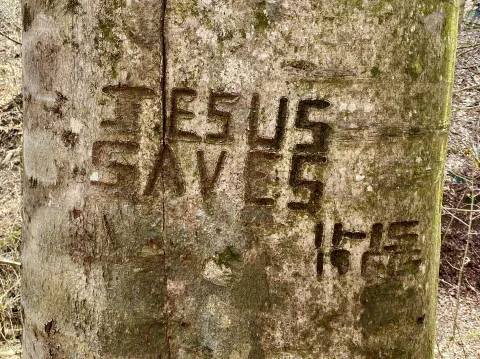American Beech

By: Steve Roark
Volunteer, Cumberland Gap National Park
The American Beech (Fagus grandifolia) is very common in our area and is to me one of the nobler trees in the forest. It has never been in high demand for timber, and so many beech trees have been left to grow large and majestic. The bark is silvery gray, smooth, and easy to identify even from a distance.
Most beech trees form large flutes where they enter the ground that act as support struts, especially on steep ground. It gives the base of the tree a dinosaur foot (with toes) appearance. The leaves of beech are spear shaped and 3-5 inches long. The leaf edge is uniformly toothed, and a vein runs from the center of the leaf rib to each tooth at the edge. The veins running from the main rib are parallel to each other and form a distinct chevron pattern.
The smooth gray bark makes beech easy to identify in winter, but there are other clues as well. The winter buds are dark reddish brown, long, slim, and sharp, reminding one of pointy cigars. The three-sided nut forms in a small, burred husk and appears in the fall. The nut is an important food source for squirrel and chipmunk, and is also used by grouse, turkey, blue jays, grosbeaks, and the titmouse. Good beechnut crops occur about every third year. Back in early American history when more and larger beech forests were present, the beechnut was an important food source for the now extinct passenger pigeon that once flew in such numbers as to darken the sky. Beech likes to grow in moist rich soil on moderate to level slopes, but these were the areas first cleared for farmland and so beech tree populations aren’t what they once were.
Because of its smooth bark, beech is often used for carving initials and dates on its surface, especially by boys in love. This form of graffiti goes back a long time, for even Shakespeare mentions it in one of his plays: "O Rosalind! These trees shall be my books, and in their bark my thoughts I'll character; that every eye which in this forest looks shall see thy virtue witness'd everywhere." Virgil, another famous writer from long ago, wrote: "Or shall I rather the sad verse repeat which on the beech's bark I lately writ." And then there's " D. Boone Cilled A Bar On Tree In Year 1760". This one was on a beech tree on Carrol Creek, in Washington County, Tennessee. The tree fell in 1916, and the Forest Service estimated it was 365 years old.
As mentioned earlier, the wood is not in high demand, but is used for such things as crates, boxes, clothespins, paper pulp, and crossties. As a medicinal, beech leaves have been boiled and used as a poultice for headaches and other mild pains. The beech nuts are edible but have also been processed and used as an antioxidant. The very young leaves have been eaten raw in a salad with other greens.
- Log in to post comments